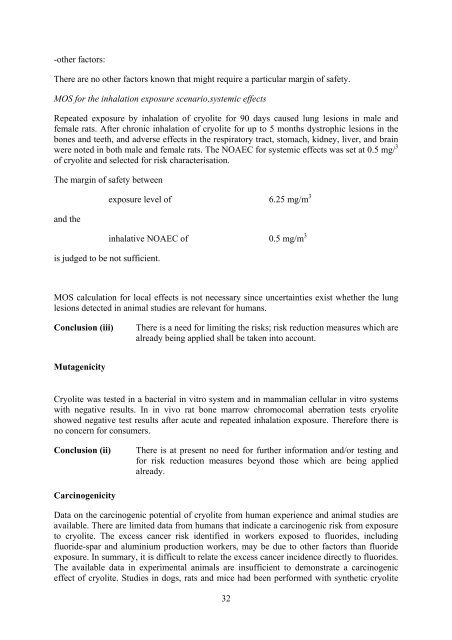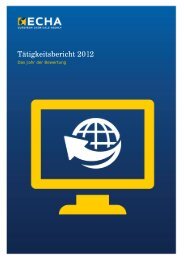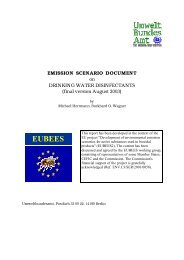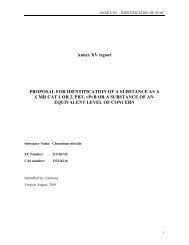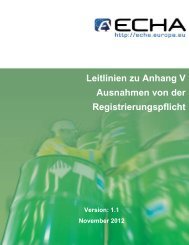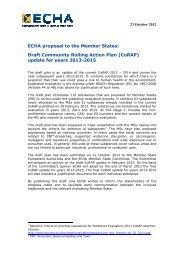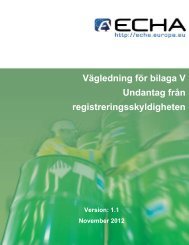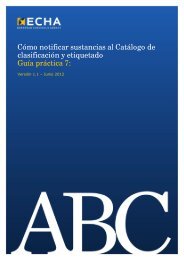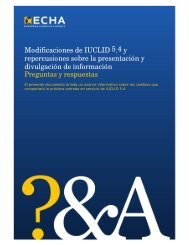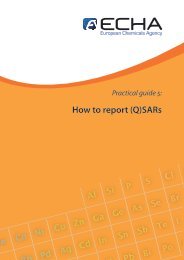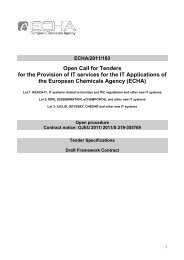Strategy For Limiting Risks Human Health Draft of ... - ECHA - Europa
Strategy For Limiting Risks Human Health Draft of ... - ECHA - Europa
Strategy For Limiting Risks Human Health Draft of ... - ECHA - Europa
You also want an ePaper? Increase the reach of your titles
YUMPU automatically turns print PDFs into web optimized ePapers that Google loves.
-other factors:<br />
There are no other factors known that might require a particular margin <strong>of</strong> safety.<br />
MOS for the inhalation exposure scenario,systemic effects<br />
Repeated exposure by inhalation <strong>of</strong> cryolite for 90 days caused lung lesions in male and<br />
female rats. After chronic inhalation <strong>of</strong> cryolite for up to 5 months dystrophic lesions in the<br />
bones and teeth, and adverse effects in the respiratory tract, stomach, kidney, liver, and brain<br />
were noted in both male and female rats. The NOAEC for systemic effects was set at 0.5 mg/ 3<br />
<strong>of</strong> cryolite and selected for risk characterisation.<br />
The margin <strong>of</strong> safety between<br />
and the<br />
is judged to be not sufficient.<br />
exposure level <strong>of</strong> 6.25 mg/m 3<br />
inhalative NOAEC <strong>of</strong> 0.5 mg/m 3<br />
MOS calculation for local effects is not necessary since uncertainties exist whether the lung<br />
lesions detected in animal studies are relevant for humans.<br />
Conclusion (iii) There is a need for limiting the risks; risk reduction measures which are<br />
already being applied shall be taken into account.<br />
Mutagenicity<br />
Cryolite was tested in a bacterial in vitro system and in mammalian cellular in vitro systems<br />
with negative results. In in vivo rat bone marrow chromocomal aberration tests cryolite<br />
showed negative test results after acute and repeated inhalation exposure. Therefore there is<br />
no concern for consumers.<br />
Conclusion (ii) There is at present no need for further information and/or testing and<br />
for risk reduction measures beyond those which are being applied<br />
already.<br />
Carcinogenicity<br />
Data on the carcinogenic potential <strong>of</strong> cryolite from human experience and animal studies are<br />
available. There are limited data from humans that indicate a carcinogenic risk from exposure<br />
to cryolite. The excess cancer risk identified in workers exposed to fluorides, including<br />
fluoride-spar and aluminium production workers, may be due to other factors than fluoride<br />
exposure. In summary, it is difficult to relate the excess cancer incidence directly to fluorides.<br />
The available data in experimental animals are insufficient to demonstrate a carcinogenic<br />
effect <strong>of</strong> cryolite. Studies in dogs, rats and mice had been performed with synthetic cryolite<br />
32


